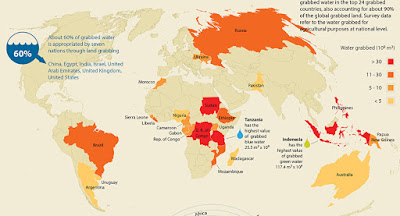The Future: Integrated Water Management?
Hello everyone! Welcome
back to my blog. The past few blog posts have considered the colonial and
post-colonial influences on water management on the Nile. In this blog post, I would like to move away from the Nile, and look deeper into the concept of Integrated Water Resource
Management (IWRM), which I briefly introduced in my post about the Grand
Ethiopian Renaissance Dam. IWRM is an important topic, as it is believed to be the
way forward with regards to dealing with issues of transboundary water
management.
IWRM in History
IWRM is a relatively new
concept, it only came into discussions after the Agenda 21 and World Summit on
Sustainable Development in 1992 (Savenijie and Van der Zaag, 2008). During the 60s and 70s water resources theory
focused on water as an exploitative resource, concentrating efforts on engineering,
and pioneering new technologies and ways of using water resources. However, in
the 80s up until the 90s it was recognized that water was a finite resource that
could be overexploited. Consequently, the focus shifted more onto the planning
aspect of water on all scales (Savenijie and Van der Zaag, 2008). IWRM grew from this understanding on the importance
of sustaining water resources for future generations- and the Dublin Principles,
discussed and established at the International Conference on Water and the
Environment (ICWE) in 1992 were a significant starting point to the integration
of this concept into various sectors on international, national and regional
scales.
1) Freshwater is a finite and vulnerable resource,
essential to sustain life, development and the environment.
2) Water development and management should be based on a
participatory approach, involving users, planners and policy makers at all
levels.
3) Women play a central part in the provision, management
and safeguarding of water.
4) Water has an economic value in all its competing uses
and should be recognized as an economic good.
This new understanding of
water management derived partly from our awareness of the growing pressures on
water resource distribution as a result of population growth. It is predicted
that by 2050 the world’s population will increase by 50% (Hassing et. al, 2009),
and most of this growth will take place in developing countries. Consequently, it
is vital that all water stakeholders play a role in managing water resources
effectively and sustainably to ensure the ability for future populations to continue
to thrive. Thus, the concept of IWRM has been considered and translated into
language understandable by people in all sectors, making it a multi-dimensional
model for sustainable development. The Global Water Partnership were one of the
first to define the theory:
“IWRM is a process which
promotes the coordinated development and management of water, land and related
resources, in order to maximize the resultant economic and social welfare in an
equitable manner without compromising the sustainability of vital ecosystems”(The Global Water Partnership, 1996 p.22).
Theory into Practice
IWRM is “not a theory
that can be proved or disproved by scholars, it’s a flexible set of suggestions
that can adapt to diverse local and national contexts” (Van der Zaag, 2005). Implementing
IWRM requires a transformation of suitable policies, strategies and legislation
surrounding sustainable water resource management and distribution. The IWRM
institutional framework must be in place for policies to be successfully implemented.
Savenije and Van der Zaag, (2008)
highlight that IWRM frameworks must consider:
-
All forms of
water resources, green and blue water combined.
-
All water users
(stakeholders), and not only the quantity available, but the importance of
quality.
-
The importance of
spatial skale (international, national, regional) in implementing management
strategies and finding solutions to key water issues.
-
The variability
of water resources (temporal scale)
Once these
considerations are made, IWRM is influenced by key decision makers. Due to its
cross-sectoral nature, it is hard for current decision makers to understand the
needs of all stakeholders in attempting reach an appropriate decision regarding
water resources. WaterNet is a network of university departments, research and
training institutions focusing on water in South and East Africa. The aim of
this foundation is to “build bridges between its key partners and those responsible
for implementing IWRM” (Afrialliance, 2017). They aim to
develop mechanisms through vigorous training and educational programs to “identify
trends and knowledge gaps across academic disciplines, professional training
and collaborative research” (Afrialliance, 2017). Their programs
are set up with the hopes of creating a new brand of water manager. Someone who
communicates with stakeholders from all fields hoping to understand all perspectives
and make a decision based off relevant information on the best way forward on
all scales (Van Der Zaag, 2005).
I hope that this post
has given you an understanding of IWRM frameworks and how they work in theory.
In my next blog post I hope to provide case studies of IWRM frameworks in
practice, as well as look at the potential challenges of this concept.



Comments
Post a Comment